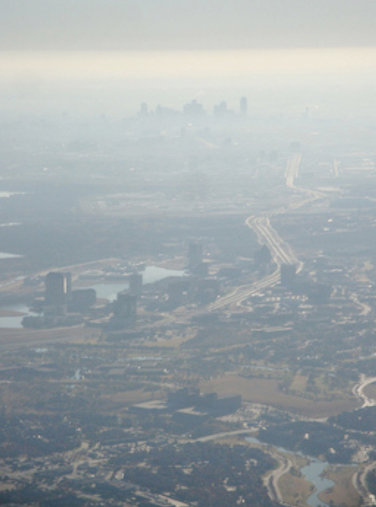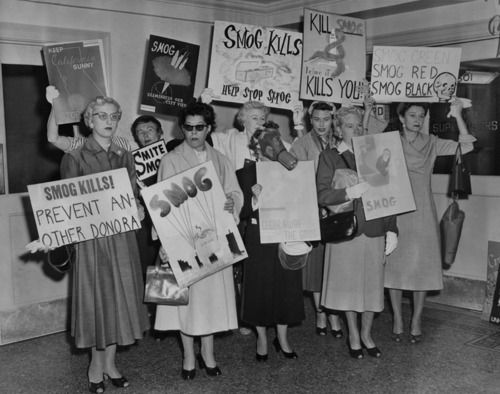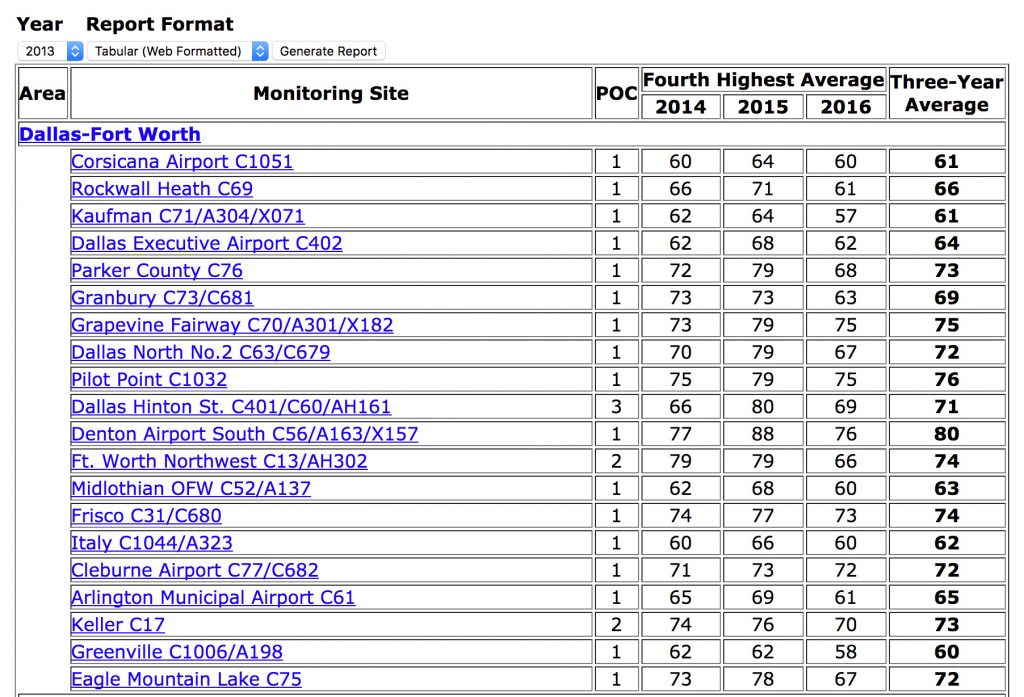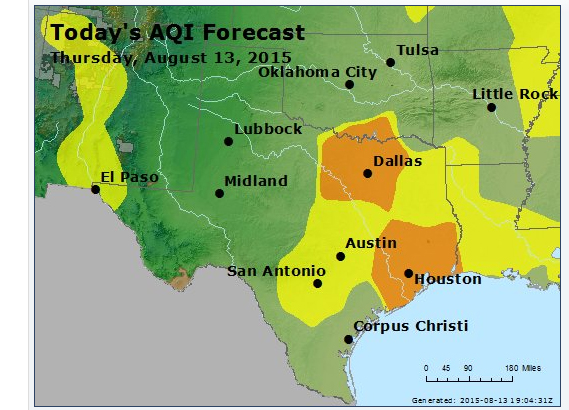Ozone
After Only Three Months into Smog Season Another State Anti-Smog Plan Has Failed
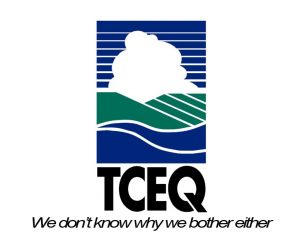 Only three months into the 2017 “ozone,” or smog, season, DFW has already recorded air pollution levels high enough to guarantee the region will remain in violation of the Clean Air Act for the 26th year in a row.
Only three months into the 2017 “ozone,” or smog, season, DFW has already recorded air pollution levels high enough to guarantee the region will remain in violation of the Clean Air Act for the 26th year in a row.
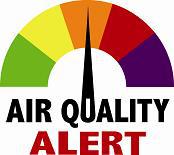
The bad news? So far, we’ve had a pretty mild kick-off to “ozone season.” Most of our worst ozone alert days have occurred on weekends on when winds were shifting.
But a couple of typical episodes in early May and June were enough to put local monitors in trouble, including the regional pacesetter at Denton Airport, to make sure that we’ll be above the current 75 parts per billion EPA standard. Only mid-way through June, Denton’s three year running average is at 78. That number can only go up as Summer wears on.
According to the the Texas Commission in Environmental Quality’s currently proposed DFW clean air plan, all monitors were supposed to be averaging 75 ppb or below.
But the Commission was never serious about that goal. For the second time since 2011, TCEQ offered up a plan that did absolutely nothing to bring smog levels down. No new controls on large sources like coal plants, cement kilns or gas compressors. No new transportation initiatives. Nothing. And nothing is what happened. And the difference between before and after the plan? Nothing. The region is still in “non-attainment” with the Clean Air Act.
Now, you might think that qualifies as a complete and utter failure as an anti-smog plan. And you’d be right. By way of common sense and the English language. But in the “Alice in Smogland” world of EPA-TCEQ agency air plan interaction and doublespeak, this State of Texas do-nothing plan has not yet failed. Bureaucratically it cannot….yet. Because it hasn’t even been approved by the EPA.
The State’s plan is still parked at Region 6 headquarters in Dallas. Why? Who knows. Pre-Trump and pre-2017 comments from EPA staff indicated it would be rejected in part or whole by now. Downwinders, other citizens groups, and elected officials were working on that assumption, trying hard to get EPA to substitute a federal plan for the state’s. The election changed all that for us, and it obviously changed the pace of decision-making at EPA.
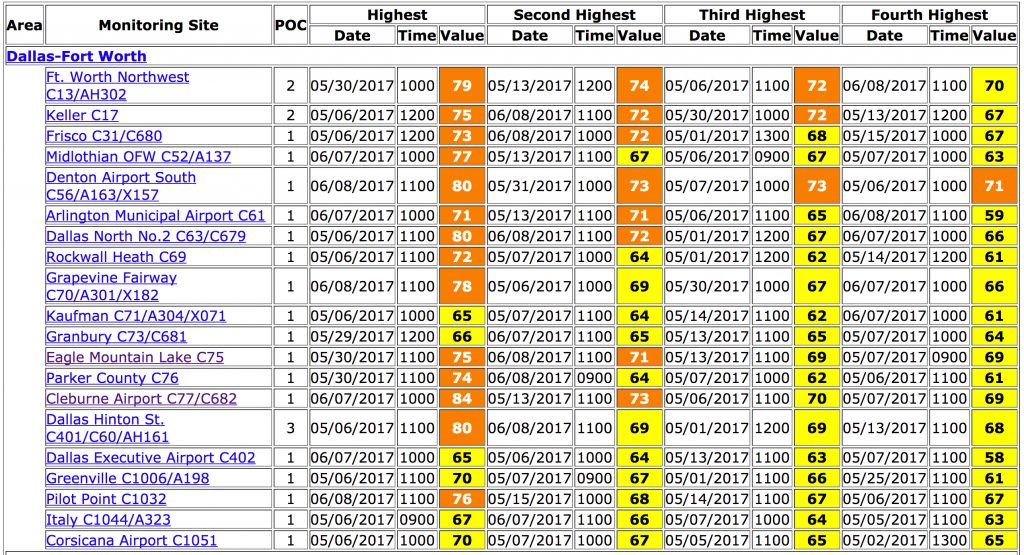
Given that it’s already failed, one would have to make a pretty good case for EPA to approve it, but again, this is a not a process always grounded in the latest facts. Now wedded to an administration that treats facts as hostile witnesses, things at EPA could get bizarre – and into court quickly.
What makes the State’s apathy worse is that EPA is letting the state get away with not providing a new plan for a current standard (even though its’ still violating it), while a new, lower standard is being (maybe) implemented over the next ….five to eight years.
But because the cut-off for violating metro areas to submit plans for the new standard was 81 ppb and DFW was at 80 last year, DFW was also given a pass by EPA to turn in a plan for the new 70 ppb standard.
So, after seeing a cycle of a plan every 3- 5 years since 1991, there will be no more anti-smog plans submitted on behalf of DFW – not for the current standard and not for the new standard. Nada. DFW won’t have to turn in a plan until well into the next decade, and then, only after it’s endangered public health by failing to meet the 70 ppb standard for three years. Of course, given our progress the last 6-7 years, it’s very possible DFW will still be violating the “old” standard.
It’s also very possible there won’t be a new 70 ppb standard. The Trump Administration has already signaled a possible roll back in EPA’s support for it. Last Tuesday, the agency gave states another year to draw non-attainment boundaries. Most had already done so with no complaints. A year from now it wouldn’t be surprising to be hearing of another delay in implementation. There’s more than one way to kill a public health standard.
May Smog Leaves the Region in Violation of the Clean Air Act for Another Year
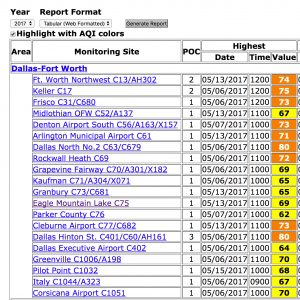 At one point in mid-May, four out of eight days were “ozone alert days.” While only one of those was critically high, the wave of higher levels was enough to push the regional average over the current 75 parts per billion (ppb) standard for 2017. It will be the 26th year in a row the DFW area has been out of compliance with the Clean Air Act’s ozone (smog) standard.
At one point in mid-May, four out of eight days were “ozone alert days.” While only one of those was critically high, the wave of higher levels was enough to push the regional average over the current 75 parts per billion (ppb) standard for 2017. It will be the 26th year in a row the DFW area has been out of compliance with the Clean Air Act’s ozone (smog) standard.
The worse news of course is that the current standard is obsolete and in the process of being lowered. The Obama EPA adopted a new 70 ppb ,and scientists advising the EPA said it really should be closer to 60-65 ppb, when many people begin noticing health effects.
To date, the Hinton Street monitor on I-35 just north of downtown Dallas and the Dallas North Site near the LBJ Freeway have the highest eight-hour averages each at 80 ppb from May 6th. Hinton saw a 1-hour reading as high as 90 ppb while North Dallas topped out at 88.
But the key to DFW’s smoggy regulatory status is the Denton monitor because it’s historically been the worst performing among the 20 North Texas monitors the state operates. It took until the May 15th episode for the wind to blow in its direction long enough to raise its numbers and to seal DFW’s ozone fate under the law for another year. It now sits at 77, barely over the current standard….but that number will rise as the summer, and ozone season progresses.
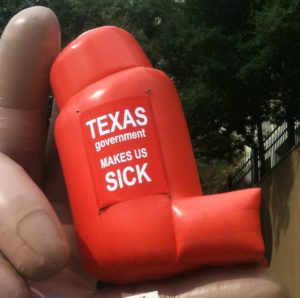
Although May saw a big wave of ozone, the region was lucky that three out of four alert days were on the weekend and shifting winds. Had the May 6th episode occurred on a Monday instead of Saturday, the numbers probably would have been significantly higher.
Forecasters have said it will be a hotter summer than last year. If so, that often portends some awful smog as well.
That’s too bad, because prospects for ANY kind of DFW clean air plan, much less a more effective one went down the tubes with the election results. There is no effective oversight by the EPA. There are no new air pollution controls being required of any major sources. We’re now completely dependent on the coattails of existing regulations, the marketplace, and whatever we can build from scratch at the local level to get us out of our dirty air rut.
Meanwhile, every so slowly, the Trump Administration is signaling it would really like to roll back that new 70 ppb smog standard to the old 75 one. It recently asked for, and got, a delay in a lawsuit filed by industry to challenge EPA’s decision. Almost every commentator believes this is in anticipation of the Trump EPA giving up the fight. But while that might be a short term victory for polluters, the law behind establishing these ozone standards makes it less likely to be a permanent one.
Nevertheless, these are more reasons for us to be about the business of becoming more self-reliant in addressing DFW’s chronic air pollution problems.
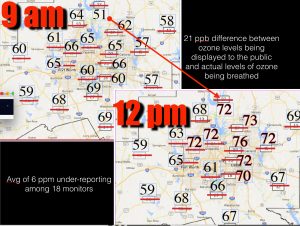
As always, every time there’s an ozone alert day, we’ll be tracking the smog on our FB site, at least as best we can when there’s a two-and-a-half-hour lag time between sample and posting of the sample on the state’s handful of monitors.
And …as you might have noticed, every time there’s a DFW ozone alert, you’ll also get a nudge from Downwinders at Risk to contribute some money to the cause of cleaner air.
Some of you may have felt assaulted by these appeals when things were getting smoggy and then smoggier in Mid-May. We apologize for the inconvenience, but not for the appeal. Ozone Alert Days are the most obvious signs of a failed state policy to provide safe and legal air to 7 million people. If we’re going to continue to be effective on your behalf, we need all the help we can get. Thanks.

Today is the Third Ozone Action Day In a Row: the State really wants you to contribute to us
This year, every time
the State of Texas
declares an
“Ozone Action Day”
We want you
to take action
by donating as little
as $5 bucks to Downwinders
_______________________________________
MONDAY, MAY 15th – The last three days in a row, and the last 4 out of 8 days have been Ozone Action Days in DFW.
Yesterday’s wind speed kept things to a duller roar, but the smog was just bad enough to push up our regional average and make sure that we’ll spend another year in violation of the Clean Air Act, no matter what else happens this summer.
That’s right, it’s only May but the smog on Sunday was bad enough for long enough in Denton yesterday to make sure the 3-year average went over the current 75 ppb standard to 77.
And we still have June, July, August and September to go.
Downwinders at Risk has been working for cleaner air here in DFW since 1994. No group has been more successful in winning pollution cuts from local industry. But these victories don’t come easy or cheap.
We’re entirely local. We depend on local donations to support the only full-time staff devoted to improving North Texas air quality.
We started this new fundraising campaign because Ozone Action Days are the most obvious signs of failure of the state’s do-nothing approach to DFW’s chronic smog problem.
When smog gets bad now, there’s something you can do that’s guaranteed to make them mad in Austin: making sure Downwinders sticks around and continues to advocate for your lungs.
We appreciate your support and promise we’ll keep fighting hard for safe and cleaner air.
To make the Powers That Be angry, please donate to help Downwinders become an even more effective advocate for safe and legal air.
Lege Slashes Air Quality Budget…Making Our Wise County Citizen Science Project More Important
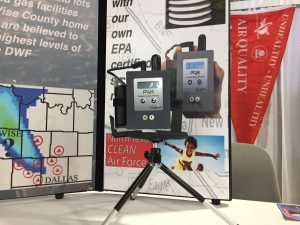 Not to be outdone by the Trump Administration’s attempted deconstruction of the Clean Air Act, the Texas House of Representatives voted in early April to take $20 million from the Air Quality Division of the Texas Commission on Environmental Quality and spend it on an alternatives to abortion program.
Not to be outdone by the Trump Administration’s attempted deconstruction of the Clean Air Act, the Texas House of Representatives voted in early April to take $20 million from the Air Quality Division of the Texas Commission on Environmental Quality and spend it on an alternatives to abortion program.
$20 million may not sound like much in a an office that has a $191 million budget, but a lot of that total is dedicated to programs in place around the state. For example, over $150 million is set aside for vehicle “emission reduction” grants to local governments in smoggy non attainment areas like Houston and DFW to subsidize new engine and repairs. A lot less is truly discretionary and a lot more at risk.
For example, TCEQ only spends a little over $6 million on grants for air monitoring. And it doesn’t get all that much bang for its buck. Only 20 monitors record smog levels over ten counties where seven million people live in DFW. This leaves huge gaps where there should be monitors but aren’t. Like Wise County.
Only Wise County isn’t just an unintentional gap in smog data. It’s a premeditated black hole, left there by design by the same TCEQ whose job it is to set-up air quality monitoring in DFW.
Over at least the last two decades, model after computer model has shown Wise County to have among the highest, if not the highest smog levels of any county in the DFW non-attainment area. Yet every time the state had the opportunity to locate a monitor to confirm those models, it passed. Why?
Because the higher the smog levels officially recorded in DFW, the more industry needs to reduce pollution by adding controls or replacing obsolete equipment.
As it is, a single tiny part per billion difference in our regional smog level was responsible for North Texas getting an exemption to turn in any plan at all for the new, and newly-endangered, 70 ppb federal ozone standard. We’re at 80. If we’d been at 81 ppb we would have had to turn in a plan. Probably a terrible one, but still a plan. A plan we could then use for court fodder to maybe get something. Now even that slim piece of leverage is gone. It’s very possible monitors in Wise County would have given us an average of 81 or greater, forcing DFW to write a plan for the brand new standard. And that’s why the current TCEQ doesn’t want a monitor there. 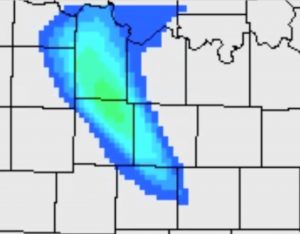
Which is why we’re going there with our own smog monitors.
We just invested $10,000 in two EPA-calibrated ozone sensors that we’re dedicating to the job of measuring Wise County smog. The monitors got their own display at Earth Day and their own photo shoot at D magazine for an upcoming article. Stay tuned for Texas Observer coverage as well. Meanwhile, here’s Culture Map’s piece.
The easiest part is done – we bought the equipment. Now we need your help in building what may the biggest and most important citizen science project in North Texas.
We’ll be launching our effort in June but we need people now who can help us build a stationary, internet-connected monitor for a location in Wise county and others who live in or near there who can help drive and take measurements from a car along a specified grid. This is your chance to actually join others and strike back against the Empire on a 24/7 basis using….SCIENCE!!!
If you’re interested in volunteering to be a Wise County Smog Tracker or want help with the Project in any capacity, please contact us at downwindersatrisk@gmail.org. Thanks.
Trump is Rolling Back Smog Standards. Get Your Anger On The Record.
What: EPA Rollback of Smog Standards – and Everything Else
Action: Submit Public Comments here ASAP
In accordance with Executive Order 13777, titled “Enforcing the Regulatory Reform Agenda,” establishing a federal policy “to alleviate unnecessary regulatory burdens,” the Trump EPA is now seeking ways to “repeal, replacement, or modify” existing regulations. Among the most prominent targets are newly-implemented smog standards and pillars of the Clean Air Act.
This follows a similar order in January, that despite coming out of the Commerce Department, was also squarely aimed at the EPA, with 48 of the 168 comments received specifically mentioning Clean Air Act regulations and 31 called for reconsidering the New Source Review process that insures continued progress in control technology.
Initially the conversation was between the regulated and regulators. But now comes the opportunity for the rest of us to officially comment. Since industry has had a considerable head start we need to make sure this public record can’t be used by the Trump Administration to justify the dismantling of the EPA.
Before they begin trying to take apart the EPA, the Trump Administration has to get public comment. You must submit your comments through the reguations.gov site. You must submit them on or before May 15, 2017.
In case you need a quick thumbnail “Hell No!,” here’s some language you can cut and past right into the regulations.gov text box online and be done with it:
As someone who lives in a region that hasn’t complied with the Clean Air Act since 1991, I reject any roll back of existing EPA regulations concerning federal ozone standards, as well as oil and gas facility emissions, greenhouse gas emissions, cement and coal plant emissions, or other large sources of air pollution. EPA should be working to protect public health, not conspiring with polluters to make regulations weaker or disappear. Improvements in air quality are documented to improve economic productivity and growth. Public health is the first priority. Keep your hands off current EPA regulations.
Trump’s Administrative Orders are just one front in the assault on Obama-era environmental regulations. Another tactic is refusing to defend new regs in court cases where industry is challenging them.
That’s exactly what happened in early April when the EPA backed out of arguing for the new 70 ppb ozone/smog standard in front of the U.S. Court of Appeals for the District of Columbia Circuit that was slated to hear oral arguments. In its filing, the Agency stated, “At this time, EPA officials appointed by the new Administration are closely reviewing the 2015 Rule to determine whether the Agency should reconsider the rule or some part of it….Given the broad-reaching economic implications of the 2015 ozone standard, we are carefully reviewing the rule to determine whether it is in line with the pro-growth directives of this Administration,” an EPA spokesperson, J.P. Freire said.
As the Oklahoma Attorney General, EPA Administrator Scott Pruitt joined Texas and eight other states in unsuccessfully fighting the initial implementation of the standards, which they said were unnecessary to protect human health. An EPA Science panel had concluded the opposite, stating lowering the standard from 75 to 70 parts per billion was the minimum necessary to protect health, and advised a more aggressive standard of 60-65 ppb, which even the Obama Administration recoiled from implementing before the 2012 election.
However, what the Trump Administration is now proposing is a roll back from the new 70 ppb standard, either by official repeal or unofficial non-enforcement, to the current 75 ppb, which will also probably be “loosely” enforced. That standard was found to be “not protective” of public health.
Because the Clean Air Act specifically says the standard must be science-based and any deviation will be headed to court, a permanent roll back is less likely than just ignoring the law, but the damage will be the same in the meantime.
In DFW this means that the current smog planning process, which had the potential to do so much good with a federal substitution of the state’s second do-nothing plan, is now DOA. That plan was another attempt to just get the region down to 75 ppb, the old standard. It didn’t even address the new 70 ppb standard now in jeopardy. We’re currently at a regional average of 80 ppb.
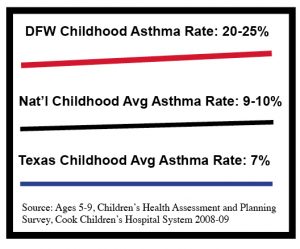 No EPA or state order will be overseeing the implementation of new controls on major sources affecting DFW air quality like the Midlothian cement kilns, East Texas coal plants or gas patch facilities, or action of any kind. Citizens will probably have to sue to get the EPA to even reject the state plan now – something it was already on the public record saying it was ready to do prior to November 20th. That rejection will, however, only trigger a rewrite by Austin. 14 million DFW lungs are now trapped by a vicious cycle of inaction that both the state and federal government are fueling.
No EPA or state order will be overseeing the implementation of new controls on major sources affecting DFW air quality like the Midlothian cement kilns, East Texas coal plants or gas patch facilities, or action of any kind. Citizens will probably have to sue to get the EPA to even reject the state plan now – something it was already on the public record saying it was ready to do prior to November 20th. That rejection will, however, only trigger a rewrite by Austin. 14 million DFW lungs are now trapped by a vicious cycle of inaction that both the state and federal government are fueling.
Other attempts by the Administration to attack the efficacy of the Agency are more structural. Seemingly with no more than spite as a motivation, there was a report circulating last month the Chicago regional EPA office would be shut down and consolidated with its Kansas City peer, with a corresponding cut in staff and resources. That’s not likely to happen for a variety of reasons, but it shows the kind of opportunistic thinking driving Agency opponents to start a fire sale. This Administration will probably not withdraw from the Paris Climate Accords, but it can be successful in blunting any EPA attempt at actual environmental protection.
That’s why it’s important not to let the opportunists at the Trump EPA win the day. We need to make sure they get a loud and clear message not to mess with the Clean air Act or anything else. Don’t hesitate. Communicate your outrage now, where it will be counted by both sides. Thanks.
Downwinders Buys Smog Monitors to Go Where No Smog Monitor Has Gone Before: Wise County
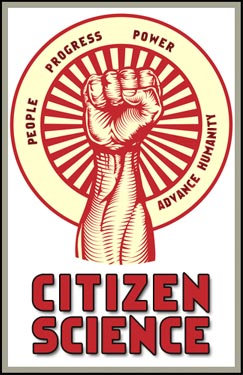 On the eve of Earth Day, clean air group Downwinders at Risk announced the purchase of two portable, EPA-calibrated ozone monitors to initiate a citizen-based monitoring campaign in Wise County this summer, where state officials refuse to measure DFW smog.
On the eve of Earth Day, clean air group Downwinders at Risk announced the purchase of two portable, EPA-calibrated ozone monitors to initiate a citizen-based monitoring campaign in Wise County this summer, where state officials refuse to measure DFW smog.
“With the purchase of these brand new high-tech monitors, which reached the market only a few months ago, we become the first group in Texas to have the capability to go out in the field and do the job the State of Texas isn’t willing to do,” said Downwinders Chair Tamera Bounds.
Downwinders newest technology will be on display at this weekend’s Earth Day Texas at Fair Park, where it’ll be a featured part of the group’s information booth. Each monitor cost approximately $5,000, fits in the palm of your hand, and comes with EPA-certified calibration to ensure reliable readings.
Wise County became the newest member of DFW’s almost-30 year “non-attainment” area for smog, or ozone pollution, in 2012. But despite computer models showing the County having some of the highest smog levels North Texas, there’s still no smog monitor located there.
Surprisingly, EPA regulations don’t require even a single ozone monitor in every non-attainment county, and Wise County is the only one of the ten DFW non-attainment counties not to have one. Bounds and her fellow clean air activists don’t believe that’s a coincidence.
Currently the Texas Commission on Environmental Quality (TCEQ) picks the sites where smog monitors are located. Denton’s airport monitor has recorded the highest levels of smog in DFW the last few years. But because of wind direction and its large number of pollution sources, computer models predict even higher levels of smog in Wise County.
That’s important because the size and scope of local clean air plans are determined by how high or low smog readings are in North Texas. The higher the smog levels, the more cuts in pollution from coal plants, cement kilns, and gas industry facilities are required to comply with the Clean Air Act.
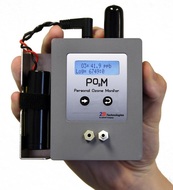 Not surprisingly, spoke persons for those industries claim such cuts aren’t needed, but the state has made the same claims despite evidence from their own computer models showing new controls could bring the area into compliance with the Clean Air Act for the first time since 1991. TCEQ also takes the position, contrary to the medical consensus, that smog isn’t bad for public health.
Not surprisingly, spoke persons for those industries claim such cuts aren’t needed, but the state has made the same claims despite evidence from their own computer models showing new controls could bring the area into compliance with the Clean Air Act for the first time since 1991. TCEQ also takes the position, contrary to the medical consensus, that smog isn’t bad for public health.
Bounds believes the TCEQ doesn’t want a smog monitor in Wise County precisely because it’d record even higher levels of the pollution than current monitors are picking up and trigger regulatory requirements to make bigger cuts.
“By not measuring smog in the place it’s predicted to be the worst, what we don’t know is hurting us,” she explained.
“Because TCEQ’s priority is to protect a handful of industrial polluters at the expense of seven million DFW residents we’re getting clean air plans based on one, rosier set of numbers, while the actual pollution levels are probably higher. That’s one reason why we’ve been in continual violation of the Clean air Act since 1991.”
Downwinders Director Jim Schermbeck said the two monitors, and others the group is buying, would be used both in stand-alone stationary locations within the County and by vehicle and drone -based platforms. They can be adapted to provide wireless connections and be plugged-in to larger networks of citizen-based monitors – something already being designed by a consortium of local universities, municipalities, and citizen groups co-founded by Downwinders.
On “high ozone days,” Downwinders will scramble a crew of citizen scientists to record ozone levels in Wise County a nd compare their results to those from other DFW monitors.
nd compare their results to those from other DFW monitors.
Besides giving the public and policymakers a more realistic view of DFW smog levels, Downwinders hope to put pressure on the EPA and the State to place one or more official ozone monitors in Wise County. Schermbeck said the group’s efforts at identifying patterns or hotspots in the County would help clean air advocates find the best place to put such a monitor.
Although the purchased monitors only arrived on the market in January, Downwinders’ Wise County Ozone Project has been over a year in planning.
It was as last year’s Earth Day Texas that Downwinders won a $3000 prize with its proposal to use small electronic air sensors combined with drone technology to provide better air pollution measurements across DFW. Wise County smog was one of the specific examples used in the presentation.
Downwinders used the Earth Day Texas funding as seed money to attract other support to fund its own North Texas CLEAN Air Force – a citizen science campaign whose first target is Wise County smog. With the purchase of the monitors, it’s believed to be the only citizens’ group in the state with the ability to independently measure ozone pollution with its own devices, much less with EPA-calibrated instruments.
Schermbeck says the group is looking to recruit both researchers who want to lend their professional help to the project, and those people who just want to help do their part in a local fight for cleaner air.“ Sadly, this is what it’s come down to in 2017 Texas: residents having to organize themselves into performing basic public health functions usually carried out by their state government.”
There’s Exactly One Full Time Clean Air Group in DFW. Please Help Us Keep It In Business.
Now that another ozone season is beginning, it’s time to remind you that Downwinders is still the only group exclusively devoted to the issue of cleaner air in Dallas-Fort Worth – an area that hasn’t been in compliance with the Clean Air Act since 1991.
Hard to believe on both counts, but it’s true.
It doesn’t matter whether it’s the Barnett Shale gas patch, the Midlothian cement plants, or the East Texas coal plants, we take on whoever and whatever is polluting DFW air.
Downwinders is the only group in DFW with a staff devoted to working on clean air issues full time. We provide the eyes and ears at daytime meetings and hearings volunteers can’t attend. We provide citizens with arms and legs to help do research and network among allies.
Downwinders does all this without the help of a home office in Austin or Washington or New York. We’re completely local, with a board composed of concerned DFW residents just like yourself. Your donations get spent on field work in North Texas.
We’re smaller than our state and national peers but our track record proves we can have a big impact. In fact, with your help, we’ve become known for being one of the most effective environmental groups in the state, no matter the size.
The operative words being “with your help.”
Without the steady stream of contributions from citizen supporters like yourself every year, we wouldn’t be able to keep staff in the field. We wouldn’t be able to dispute the state’s bogus claims of no harm from smog, or hold the EPA accountable.
We wouldn’t be able to host our annual Root and Branch Revue for grassroots activists, or run fruitful experiments like the College for Constructive Hell-Raising.
We know things are looking grim now. But imagine how much worse it could be without a Downwinders at Risk looking out on behalf of your lungs.
Thanks for your consideration.
Have You Seen Me? The Missing DFW Clean Air Plan
 Somewhere deep in the cubicled bowels of the Region 6 EPA offices in downtown Dallas lies a draft of a letter to the State of Texas telling Austin it’s proposed clean air plan for DFW is inadequate and must be re-written.
Somewhere deep in the cubicled bowels of the Region 6 EPA offices in downtown Dallas lies a draft of a letter to the State of Texas telling Austin it’s proposed clean air plan for DFW is inadequate and must be re-written.
It likely goes through the litany of well-known public objections the EPA has about the plan, originally expressed while it was being drafted by the Texas Commission on Environmental Quality:
- The state’s computer air modeling’s predictions of drops in pollution are “unrealistic.”
- The state’s plan doesn’t do anything about pollution from the old East Texas coal plants despite evidence “strongly supporting” the link between their poisons and DFW smog.
- Air quality monitors in the gas patch are lagging behind other DFW area monitors in showing decreases in smog over the last decade, indicating pollution from gas patch facilities is slowing air quality progress, but the state’s plan doesn’t reduce it either.
- Despite a brand new state-of-the-art pollution control system that could cut smog pollution by 70-90% being voluntarily installed at one cement kiln in Midlothian, the state is not requiring the other three kilns install the same technology.
Which is all longhand for “this plan is not cutting enough air pollution to work.”
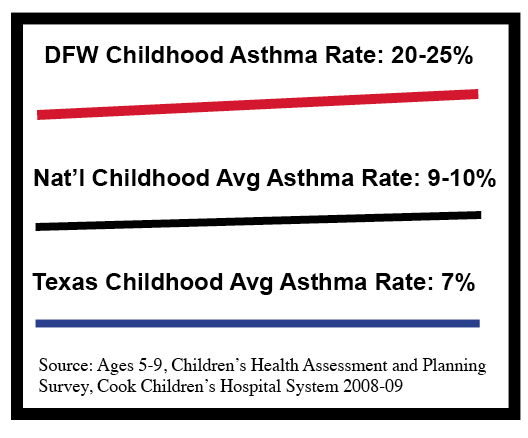 The current standard for smog, or ozone pollution, is 75 parts per billion over an eight hour period. That’s supposed to come down to 70 in the next few years as a new, more protective federal standard is applied.
The current standard for smog, or ozone pollution, is 75 parts per billion over an eight hour period. That’s supposed to come down to 70 in the next few years as a new, more protective federal standard is applied.
DFW’s eight hour average is 80 parts per billion at the start of this “ozone season.” (based on the numbers coming out of the Denton air quality monitor) The North Texas region has never been in compliance with the smog standard, even when it was 120 parts per billion over just an hour. That’s 26 years of bad air and counting.
The state’s plan is supposed to be response to this problem, but for the second time in a row, Texas has written an air plan for DFW that does nothing at all.
Before November, that plan was going to be rejected, in part, or whole, as insufficient by EPA, sent back to Austin for a re-write and then, fingers crossed, Downwinders and others were hoping to persuade the Agency to substitute its own federal plan of action. That would have been a first for DFW.
In December, Dallas County Commissioner Dr. Theresa Daniel, Dallas Council member Sandy Greyson, Dallas Mayor Mike Rawlings, staff representing Congresswoman Eddie Bernice Johnson and Congressman Marc Veasey, members of the Dallas County Medical Society and Downwinders members all pleaded with EPA Regional Administrator Ron Curry to try and persuade him to reject the state plan and implement a federal one before Inauguration Day.
Curry’s response was to say that timeline was too fast – despite having had the state plan in-house at EPA for over a year, and access to its conclusion for even longer. Plus, he said reassuringly, they’d all gone through “transitions” from one administration to another. Everything would be all right.
Donald Trump will not be able to revive the coal industry. He will not be able to revoke President Obama’s climate change policies en masse without court fights. Meta national and international trends are beyond his gutted EPA’s reach to impact. But he can keep seven million DFW residents from breathing safe and legal air for the next decade.
Right now, the state clean air plan for DFW is still parked at EPA. Because of the change in administrations, the staff is probably being told to do the math twice and make only the most conservative calls. That may mean rejecting only certain parts of the plan, albeit critical ones, like the section that promises to get down to 75 ppb by the end of this summer.
Yes, that was the original goal of the plan way back when it started being put together in 2014-15. If we have another cooler, wetter summer it’s possible we could get close. If we have a typical DFW summer, the smog might get worse, as it did the last time a state clean air plan that did nothing was being implemented in 2011.
Besides rejecting the “attainment” part of the attainment plan, the EPA could also reject the way the state defined new control technologies as impractical or too costly despite being widely used in industry. One example is electrification of compressors in the gas patch. Even the gas and oil’s industry’s own textbooks cite this one simple switch in power sources, from diesel or gas to electricity to power huge, locomotive size pipeline compressors, as being the standard fix in metropolitan areas with bad air.
But the state’s rejecting requiring electrification because it says it just isn’t practical to expect that those compressors can find power close enough to the grid to plug-in….in the fourth largest urban area in the country.
Another example are the three Midlothian cement plants, still the single largest sources of air pollution in DFW.
One cement plant operator has voluntarily installed what’s considered to be a state-of-the art pollution control system that’s capable of reducing smog-forming emissions by 70-90%. This system is also being used with great effect in Europe on almost a dozen plants. But the state’s plan doesn’t take note of this sea-change in technology and doesn’t require the other three cement plants in Midlothian to install it, saying it hasn’t been proven yet – even though it’s in full scale operation in a Texas cement kiln right now.
But while the local EPA staff may have felt more confident about making those calls on new pollution controls in a Clinton administration, it’s unlikely they’ll advocate for them now, knowing their new bosses in DC will not approve.
So they’ll put a big’ ol “REJECT” stamp on the state’s paperwork and and send it back to Austin for a redo.
From where it will never see the light of day again.
Officially, when the EPA rejects a state clean air plan, it triggers a two-year deadline to come up with another one. So normally, the state would go through the motions and eventually churn out another plan, it would be found inadequate by EPA again, the whole thing would wind up in court and either the EPA and/or environmentalists would win some concessions.
But the EPA is transitioning from one smog standard to another. There’s a gap in enforcement of the old standard to get ready for the new one. So the State of Texas, which hasn’t even tried to write a serious clean air plan in decade, and doesn’t even believe smog is bad for you, will get a Mulligan from the EPA for not being able to produce a clean air plan for DFW that works.
Not only will the state of Texas not be penalized for writing an ineffective clean air plan, but if DFW is still not in compliance with the older 75 ppb smog standard by the end of this summer, it won’t be penalized for that either. Because now the EPA is switching over to the 70 ppb standard – and there are brand new deadlines for brand new clean air plans….for the State of Texas to willfully ignore.
Greg Abbott will not be punished for ignoring the law. The Texas Legislature will not be punished. Nobody at TCEQ will pay a price for once again not doing their job.
No, the only people being punished for the state’s aggressive neglect of its air are DFW’s residents, who must breathe the results of that neglect for almost half of every year now. Make no mistake about it, it’s a statistical certainty that neglect is killing people and making them sick. Dr. Robert Haley’s landmark study using the state and EPA’s own data shows that number could be as high as 100 victims a year.
Now add a Trump EPA to the mix.
DFW is not in compliance with the current/old 75 ppb smog standard. The Texas plan to get it in compliance is inadequate. The leftover Obama EPA will say so and send it back to Austin. The state will sit on the plan six months, then resubmit it. A Trump EPA will now find this previously inadequate plan quite adequate, even if the region still isn’t in compliance with the old standard.
But wait, there’s more.
You’d think a region in continual non-compliance with the Clean Air Act for almost three decades would be a priority for receiving an effective clean air plan. You’d be wrong.
In fact, since DFW average is currently 80 ppb of smog, and not 81 ppb, the state of Texas does not even have to submit a clean air plan for DFW until AFTER the region fails to meet the new 70 ppb standard by 2020, at which point Texas will have two more years to write another plan that does nothing.
This is how 80,000 votes spread over three Midwestern states can poison the air for seven million Texans.
The one thing that could throw a wrench into this scenario? Court cases filed by environmentalists to make sure EPA doesn’t allow backsliding in DFW air quality. But that is a very thin green line on which your lungs can pin hope, and it will always be after the barn door has already been left for too long.
We’ve gone from being on the precipice of what would have been the first real pollution reduction plan for DFW in a decade, to now looking at a decade of no action at all outside that which we can generate as citizens defending ourselves. In 2017, Environmental protection in Texas is very much a Do-It-Yourself proposition.
As the region’s only group charged with the job of protecting our air, Downwinders is looking at starting from scratch and reassessing our strategy. We have to find new ways to leverage our need for safe and legal air. We worked hard for over three years to win a good air plan. Now it’s back to the drawing boards.
One of the things we’re putting a lot of effort and money into building is our own independent air quality monitoring network. There are only 20 smog monitors for all of North Texas, half of which are used in rural areas for boundary readings. There are no smog monitors in Wise County, despite all the computer models showing it to be where the highest levels of the pollution are probably located.
If we can do a better job of documenting bad air, we make the case for why we need more actions to reduce air pollution, instead of do-nothing plans from Austin.
Chris Turner Becomes First State Representative to Ask EPA for new DFW Air Plan
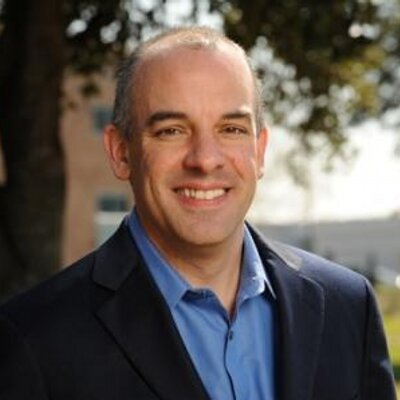 State Representative Chris Turner, whose District 101 spans west Grand Prairie and east Arlington between Dallas and Fort Worth became the first state elected official to urge EPA to reject the current state anti-smog plan for DFW and substitute one of its own.
State Representative Chris Turner, whose District 101 spans west Grand Prairie and east Arlington between Dallas and Fort Worth became the first state elected official to urge EPA to reject the current state anti-smog plan for DFW and substitute one of its own.
In a letter to EPA Chief Gina McCarthy, Turner used language echoing the sentiments of US Congresswoman Eddie Bernice Johnson and Congressman Marc Veasey.
"While I hope that the TCEQ will take the public comments it received by EPA, the Texas Medical Association, and others into consideration and require additional emissions controls in the final SIP revision it submits to EPA, I ask you to consider rejecting the state's plan use of a Federal Implementation Plan if your agency decides that the final SIP revision is insufficient and the state will not negotiate in good faith."
The entire letter can be read here.
Besides Johnson and Veasey's letters, Dallas County and the City of Dallas have voted in favor of resolutions condemning the currently proposed plan has being inadequate. More cities and counties are expected to pass similar resolutions as elected bodies come back from summer breaks.
Members of the DFW Clean Air Network (DFW CAN) – Downwinders at Risk, the Sierra Club, Beyond Coal, the Texas Campaign for the Environment, Mansfield Gas Well Awareness and Livable Arlington – are also out and about obtaining letters like Turner's from other state and federal elected officials.
Turner's district is directly downwind of the Midlothian cement plants and includes numerous natural gas wells and facilities. Gas sources are now the fourth largest contributor to DFW smog.
According to EPA, the state plan arrived at the EPA's doorstep August 8th, but it's already DOA.
Although ozone season is far from over and it's been a relatively mild "season" so far, we know in its second full year out of the three years allotted for success, the state air plan will, at best, have brought down ozone levels by 1 ppb from 2015 levels, to 80 ppb. We're supposed to be at 75.
The parrot is dead. We're just waiting for the state to admit it – or the EPA to shut the farce down.
Meanwhile, the more political support on the ground in DFW for an EPA alternative that might actually reduce emissions from major sources in North Texas like gas, cement kilns, and coal plants, the more likely it is for the Agency to accept the challenge, and endure all the pushback from Austin it'll get if it decides to take over the job.
If you're interested in trying to get your city, county, or state or federal elected officials to join the band wagon and reject the state plan, write or call us and we'll work with you in getting something accomplished that can add to the momentum.
We Already Know the State Air Plan for DFW has Failed a Second Year In a Row. The Only Question is By How Much.
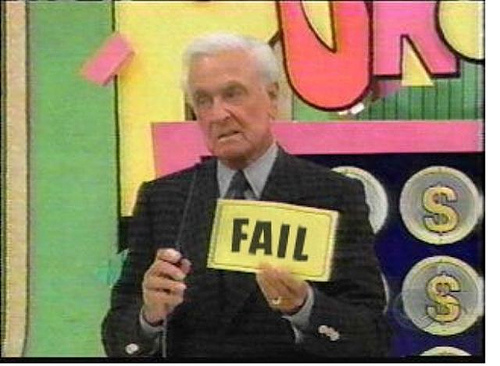 It's only July, but midway through its second year, we already know the state's air "plan" for DFW has once again failed to obtain compliance with the current 75 parts per billion ozone standard.
It's only July, but midway through its second year, we already know the state's air "plan" for DFW has once again failed to obtain compliance with the current 75 parts per billion ozone standard.
Last year the regional peak went from 80 to 81 ppb based on a rolling three-year average of readings from the Denton monitor. Even though we've only had one or two awful ozone weeks this year so far, those were enough to establish a 2016 Denton monitor average of 80 ppb going into what are tradtionally the smoggier months of August and September. So two years in, the state's plan can do no better than get us back to where we started in 2014 – and might do considerably worse.
Officially, the state's only hope for last-minute success is a drastic drop in smog at the Denton monitor next year in order to swing the three-year running average. Those hopes are hanging by a tailpipe with the scheduled introduction by the federal governement next summer of a new, lower-sulfur gasoline mixture for all U.S. cars and trucks. Austin's "plan," such as it is, is to ride the coattails of that change in gasoline formula in hopes its widespread use will significantly lower smog numbers thoughout DFW.
EPA agrees with Texas that they'll be a decline in vehicle-generated smog due to the new gas mix. However, it disagrees that it alone will be able to bring DFW into compliance with the Clean Air Act by the end of ozone season in 2017. At this point, the Denton monitor would have to have a 2017 fourth-highest reading of 64 ppb or lower to come in at a running average of 75 ppb. Not impossible, but it requires an unprecedented 10-11 ppb annual drop from the current average, much less the higher one that August or September might deliver.
The state can keep saying the clock is still ticking on their plan, but the numbers are already in, and they aren't cooperating.
This kind of math is the reason why Downwinders, the Sierra Club and other groups are requesting EPA to reject the state plan that now has arrived at its doorstep. It's the reason both Dallas County and the City of Dallas passed resolutions requesting the same, and the reason why both Congresswoman Eddie Bernice Johnson and Congressman Marc Veasey wrote a letter directly to EPA asking that the agency step in and do the job the state will not do.
Rejection of the bad state plan is the necessary first step in setting the stage for a more comprehensive EPA plan – one that would include all the large sources of smog pollution affecting DFW that have been untouched by state air plans over the last decade: like the oil and gas industry, the Midlothian cement kilns, and the East Texas coal plants.
We're tired of failure. We've experienced 25 years of it. We're experiencing it again this year. If you're tired of dirty air too, please contact us about how your city and county can pass a resolution asking the EPA to reject the state's plan and start writing one that will actually work.


